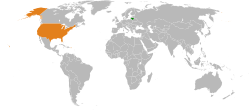Lithuania–United States relations
 | |
Lithuania |
United States |
|---|---|
Lithuania is one of the most pro-United States nations in Europe and the world, with 73% of Lithuanians viewing the U.S. positively in 2011.[1] According to the 2012 U.S. Global Leadership Report, 48% of Lithuanians approve of U.S. leadership, with 20% disapproving and 32% uncertain.[2]
History[]

The United States established diplomatic relations with Lithuania on July 28, 1922. The Soviet invasion forced the closure of the Legation to Lithuania on September 5, 1940, but Lithuanian representation in the United States continued uninterrupted. The United States never recognized the forcible incorporation of Lithuania into the USSR and views the present government of Lithuania as a legal continuation of the interwar republic. In 2007, the United States and Lithuania celebrated 85 years of continuous diplomatic relations. Lithuania has enjoyed most-favored-nation treatment with the United States since December 1991. Since 1992, the United States has committed more than $100 million in Lithuania to economic and political transformation and to humanitarian needs. The United States and Lithuania signed an agreement on bilateral trade and intellectual property protection in 1994 and a bilateral investment treaty in 1997. In 1998, the United States signed a "" with Lithuania and the other Baltic countries establishing bilateral working groups focusing on improving regional security, defense, and economic issues.
Today, over 650,000 individuals who identify as Lithuanian American live in the United States. Lithuanian immigration began before the United States even became a country, with individuals like Alexander Curtius settling in New Amsterdam (what would later become New York City) in 1659. Lithuania was part of the Polish–Lithuanian Commonwealth until 1795, when it was largely incorporated into the Russian Empire. Despite attempts by the Tsarist government in Moscow to prevent residents of the empire from emigrating, many Lithuanians came to the United States throughout the 19th and early 20th Centuries, settling primarily in the Northeast (especially Pennsylvania) and the Midwest. Lithuanian immigration tapered off with the passage of nativist legislation like the Emergency Quota Act of 1921 and the Immigration Act of 1924 in Congress. Smaller waves of Lithuanian migration to the United States occurred at the end of World War II (thanks to the Displaced Persons Act) and when Lithuania regained independence following the dissolution of the Soviet Union in 1990.
Principal U.S. officials include[citation needed]:
- Ambassador—Deborah McCarthy[3]
- Deputy Chief of Mission—Anne Hall
- Political and Economic Section Chief—John M. Finkbeiner Jr.
- PAO—Jonathan M. Berger
- Defense Attaché—Jeffrey L. Jennette
- Defense Cooperation Officer—Cynthia A. Matuskevich
- Management Officer—Alboino L. Deulus
- Consular Officer—Anthony T. Beaver
The U.S. Embassy in Lithuania is located in Vilnius (Akmenu 6).
Principal Lithuanian officials include[citation needed]:
- Ambassador - [4]
- Executive Assistant to the Ambassador - Eglė Janeliūnaitė
- Deputy Chief of Mission - Tomas Gulbinas
See also[]
- Lithuanian Americans
- Foreign relations of the United States
- Foreign relations of Lithuania
References[]
- ^ Opinion of the United States Pew Research Center
- ^ U.S. Global Leadership Project Report - 2012 Gallup
- ^ Deborah A. McCarthy U.S. Department of State, accessed February 17, 2016
- ^ [1] Lithuanian Embassy, accessed May 1, 2016
![]() This article incorporates public domain material from the United States Department of State website https://2009-2017.state.gov/r/pa/ei/bgn/5379.htm.
This article incorporates public domain material from the United States Department of State website https://2009-2017.state.gov/r/pa/ei/bgn/5379.htm.
Further reading[]
- Alilunas, ed., Leo J (1978). Lithuanians in the United States: selected studies. R & E Research Associates. ISBN 9780882474878. OCLC 4005548.CS1 maint: extra text: authors list (link)
- Budreckis, Algirdas (1976). The Lithuanians in America, 1651-1975: A Chronology and Fact Book. Oceania Publications. OCLC 164038424.
- Gedmintas, Aleksandras. “Lithuanians.” In American Immigrant Cultures: Builders of a Nation, Vol. 2, edited by David Levinson and Melvin Ember, (Macmillan, 19970 pp 588–96..
- Granquist, Mark A. "Lithuanian Americans." in Gale Encyclopedia of Multicultural America, edited by Thomas Riggs, (3rd ed., vol. 3, Gale, 2014), pp. 111–127. Online
- Kuzmickaitė, Daiva Kristina. Between Two Worlds: Recent Lithuanian Immigrants in Chicago (1998–2000). (Vilnius: Versus Aureus, 2003).
- Kelly, Mary E (1996). Born again Lithuanians : ethnic conversions and pilgrimages and the resurgence of Lithuanian-American ethnic identity. University of Kansas. OCLC 35004843.
- Senn, Alfred Erich; Eidintas, Alfonsas (Spring 1987). "Lithuanian Immigrants in America and the Lithuanian National Movement before 1914". Journal of American Ethnic History. 6 (2): 5–19. JSTOR 27500524.
- "Lithuanians" in Thernstrom, Stephan, Ann Orlov and Oscar Handlin, eds. Harvard Encyclopedia of American Ethnic Groups (1980) Online
External links[]
| Wikimedia Commons has media related to Relations of Lithuania and the United States. |
- Lithuania–United States relations
- Bilateral relations of the United States
- Bilateral relations of Lithuania